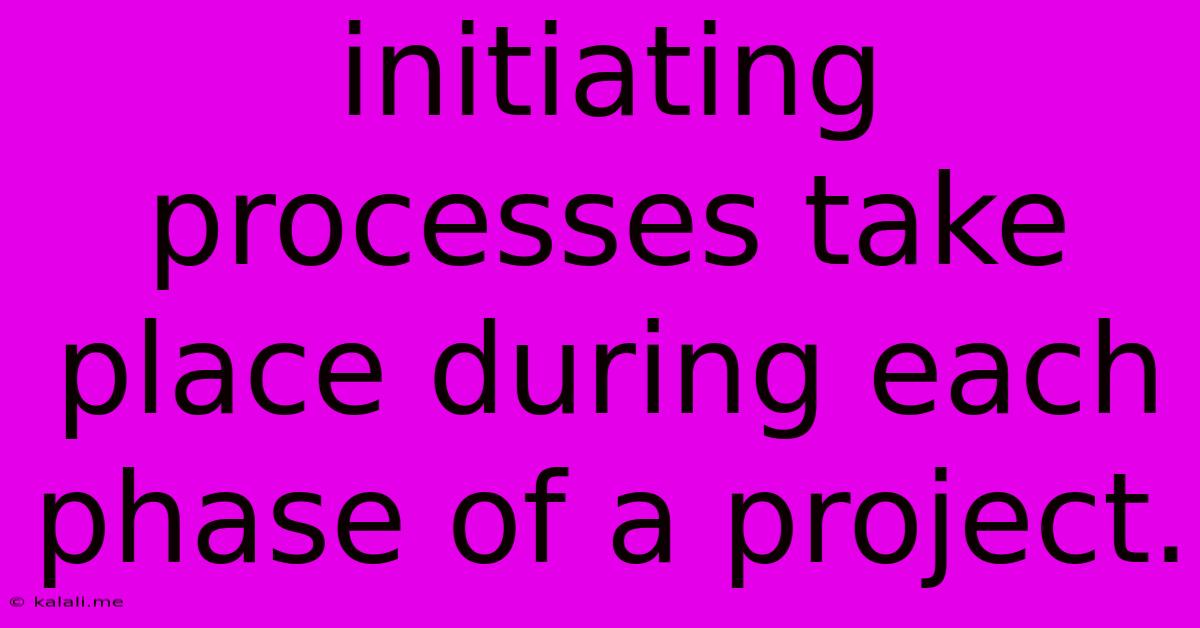Initiating Processes Take Place During Each Phase Of A Project.
Kalali
Jun 02, 2025 · 4 min read

Table of Contents
Initiating Processes in Each Project Phase: A Comprehensive Guide
Meta Description: Learn how to effectively initiate processes during each project phase, from conception to completion. This guide covers key activities and best practices for successful project management.
Successfully managing a project hinges on effectively initiating processes at each stage. It's not just about starting work; it's about strategically planning and preparing for each phase to ensure smooth execution and successful delivery. This article provides a comprehensive overview of initiating processes in each phase of a project lifecycle.
Phase 1: Project Initiation
This phase lays the foundation for the entire project. Effective initiation here prevents costly rework and delays later on. Key processes include:
-
Defining the Project Scope: Clearly articulating project goals, deliverables, and objectives. This involves creating a detailed project charter outlining the project's purpose, key stakeholders, high-level timelines, and budget constraints. A well-defined scope reduces ambiguity and keeps the project focused.
-
Identifying Stakeholders: Identifying all individuals or groups impacted by or involved in the project. Understanding their needs and expectations is crucial for effective communication and collaboration throughout the project lifecycle. Stakeholder analysis helps prioritize communication strategies and manage expectations effectively.
-
Developing a Project Management Plan: This plan outlines the project's methodology, timelines, resources, risk management strategy, and communication plan. This serves as the roadmap for the entire project, ensuring everyone is on the same page. It often includes a work breakdown structure (WBS) to further detail tasks.
-
Securing Resources: Identifying and securing all necessary resources including personnel, budget, equipment, and software. This ensures that the project has the necessary support to proceed smoothly. Resource allocation should be carefully planned and monitored throughout the project.
-
Risk Assessment and Mitigation: Identifying potential risks and developing strategies to mitigate them. Proactive risk management minimizes disruptions and keeps the project on track. This includes developing contingency plans for foreseeable challenges.
Phase 2: Project Planning
With the project initiated, the planning phase focuses on detailed execution strategies. Key initiating processes here are:
-
Detailed Task Breakdown: Breaking down the project into smaller, manageable tasks with clearly defined responsibilities and deadlines. This is where the WBS is refined and tasks are assigned to specific team members.
-
Resource Allocation (Detailed): Allocating specific resources to each task, ensuring availability and avoiding resource conflicts. This often involves creating a resource schedule and tracking resource utilization.
-
Defining Communication Protocols: Establishing clear communication channels and protocols to ensure effective information flow among team members and stakeholders. This might involve setting up regular meetings, using project management software, or establishing communication escalation paths.
-
Developing a Quality Management Plan: Defining quality standards and processes to ensure the project deliverables meet the required quality level. This could include defining acceptance criteria and quality control checkpoints.
-
Baseline Setting: Establishing a baseline project plan against which progress will be measured. This serves as a reference point for tracking variances and making necessary adjustments.
Phase 3: Project Execution
This is the phase where the actual work takes place. Initiating processes at this stage focus on:
-
Team Kick-off Meeting: A meeting to formally launch the project, ensuring all team members understand their roles, responsibilities, and the overall project goals. This helps build team cohesion and commitment.
-
Process Monitoring and Control: Regularly monitoring the project's progress against the plan and making necessary adjustments to stay on track. This involves using project management tools to track tasks, timelines, and resources.
-
Change Management Process: Establishing a formal process for managing changes to the project scope, timeline, or budget. This is crucial for maintaining control and avoiding scope creep.
-
Issue Log Initiation: Establishing a central repository for documenting and tracking issues and risks. This promotes transparency and facilitates timely resolution of problems.
Phase 4: Project Monitoring and Controlling
Ongoing throughout the project lifecycle, this phase necessitates continuous initiation of:
-
Progress Reporting: Regularly reporting on the project's progress to stakeholders, highlighting achievements, challenges, and risks. This keeps everyone informed and allows for proactive adjustments.
-
Variance Analysis: Analyzing deviations from the baseline plan and identifying their causes. This helps in making informed decisions and adjusting the project plan as needed.
-
Performance Measurement: Tracking key performance indicators (KPIs) to assess the project's performance and identify areas for improvement. This ensures the project is on target to meet its objectives.
Phase 5: Project Closure
Even the end of a project requires initiation:
-
Formal Acceptance: Obtaining formal acceptance of the project deliverables from stakeholders. This ensures that the project has met its objectives and that stakeholders are satisfied.
-
Project Documentation Archiving: Archiving all project documents, including the project plan, progress reports, and any other relevant information. This is crucial for future reference and lessons learned.
-
Post-Project Review: Conducting a post-project review to evaluate the project's success and identify areas for improvement in future projects. This is essential for continuous improvement.
By effectively initiating processes at each phase, project managers can enhance project success rates, reduce risks, and ultimately deliver projects on time and within budget. Remember, initiating isn't a one-time event – it's a continuous cycle of planning, preparation, and execution crucial for navigating the complexities of any project.
Latest Posts
Latest Posts
-
Make Followers Stop Attacking Each Other Skyrim
Jun 04, 2025
-
Should Normal Exposure Be Higher For Resin Build Plate Adhesion
Jun 04, 2025
-
Are Cells Usually Negative On The Inside
Jun 04, 2025
-
30 Amp Sub Panel For Shed
Jun 04, 2025
-
Borderlands 2 Odds Of Slot Machines
Jun 04, 2025
Related Post
Thank you for visiting our website which covers about Initiating Processes Take Place During Each Phase Of A Project. . We hope the information provided has been useful to you. Feel free to contact us if you have any questions or need further assistance. See you next time and don't miss to bookmark.